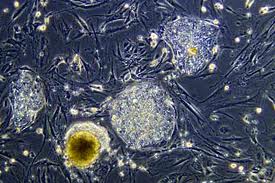导读:帕金森氏症是一种常见于中老年人的神经系统疾病。与人脑部的神经传导物质多巴胺减少有关。此前,科研人员已利用与胚胎干细胞功能接近的人类诱导多功能干细胞制成可产生多巴胺的神经细胞,并在猴子身上进行过类似实验,结果证明能有效减轻这些灵长类动物的帕金森氏症症状。

日本一个联合研究小组2月21日宣布,他们用人胚胎干细胞成功使患帕金森氏症的猴子症状改善,这种新方法将来有望用于临床治疗。
这个研究小组的成员来自京都大学和日本理化研究所。据介绍,研究人员利用人胚胎干细胞制造能产生神经传导物质多巴胺的神经细胞,然后将这些神经细胞移植到4只患帕金森氏症的食蟹猴脑部,并持续观察1年,结果发现猴子手脚震颤的症状得到明显改善。
帕金森氏症是一种常见于中老年人的神经系统疾病。与人脑部的神经传导物质多巴胺减少有关。主要症状包括手脚震颤、动作迟缓、肌肉僵硬等。
此前,科研人员已利用与胚胎干细胞功能接近的人类诱导多功能干细胞制成可产生多巴胺的神经细胞,并在猴子身上进行过类似实验,结果证明能有效减轻这些灵长类动物的帕金森氏症症状。
有关上述新疗法的研究论文已刊登在最新一期美国学术期刊《干细胞》网络版上。领导这个研究小组的京都大学副教授高桥淳说,今后准备进一步提高实验安全性,并在3年后开始临床应用研究。

Prolonged Maturation Culture Favors a Reduction in the Tumorigenicity and the Dopaminergic Function of Human ESC‐Derived Neural Cells in a Primate Model of Parkinson's Disease
Doi, Daisuke; Morizane, Asuka; Kikuchi, Tetsuhiro; Onoe, Hirotaka; Hayashi, Takuya; Kawasaki, Toshiyuki; Motono, Makoto; Sasai, Yoshiki; Saiki, Hidemoto; Gomi, Masanori; Yoshikawa, Tatsuya; Hayashi, Hideki; Shinoyama, Mizuya; Mohamed, Refaat; Suemori, Hirofumi; Miyamoto, Susumu; Takahashi, Jun
For the safe clinical application of embryonic stem cells (ESCs) for neurological diseases, it is critical to evaluate the tumorigenicity and function of human ESC-derived neural cells in primates. We have herein, for the first time, compared the growth and function of human ESC-derived cells with different stages of neural differentiation implanted in the brains of primate models of Parkinson's disease. We herein show that residual undifferentiated cells expressing ESC markers present in the cell preparation can induce tumor formation in the monkey brain. In contrast, a cell preparation matured by 42-day-culture with BDNF/GDNF treatment did not form tumors, and survived as primarily dopaminergic neurons. In addition, the monkeys with such grafts showed behavioral improvement for at least 12 months. These results support the idea that human ESCs, if appropriately matured, can serve as a source for dopaminergic neurons without forming any tumors in a primate brain.
文献链接:https://onlinelibrary.wiley.com/doi/10.1002/stem.1060/abstract








